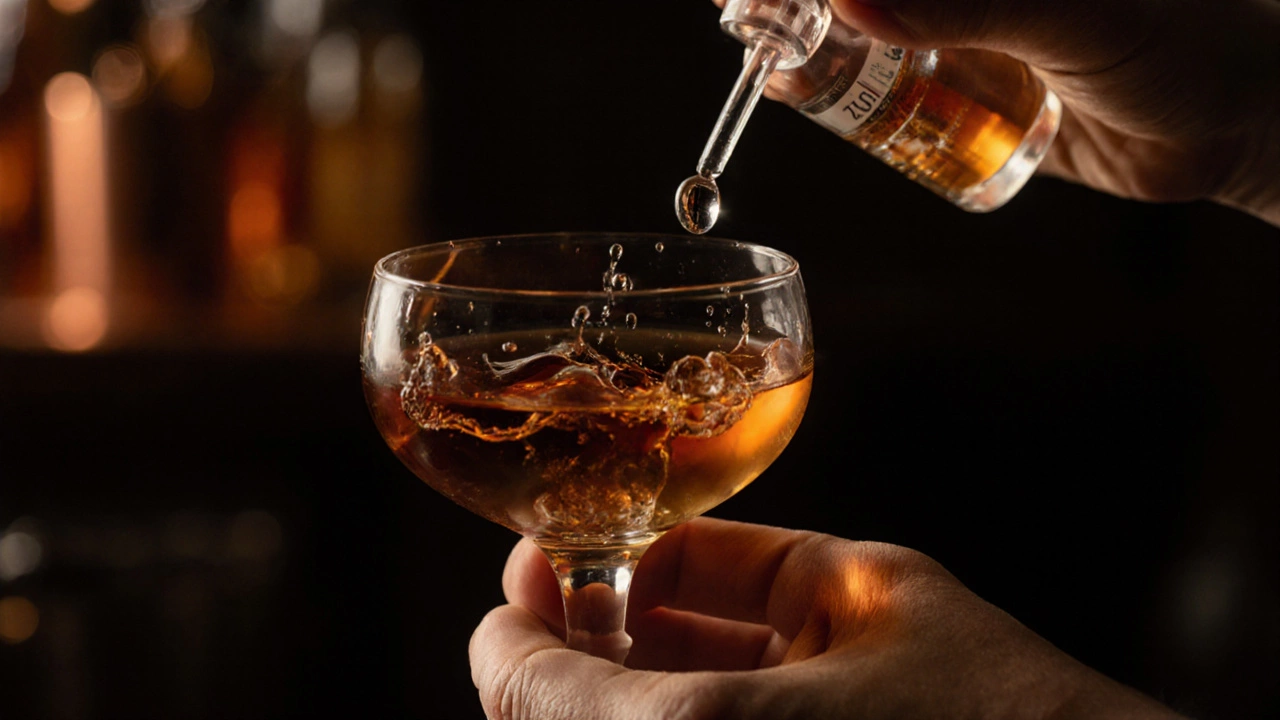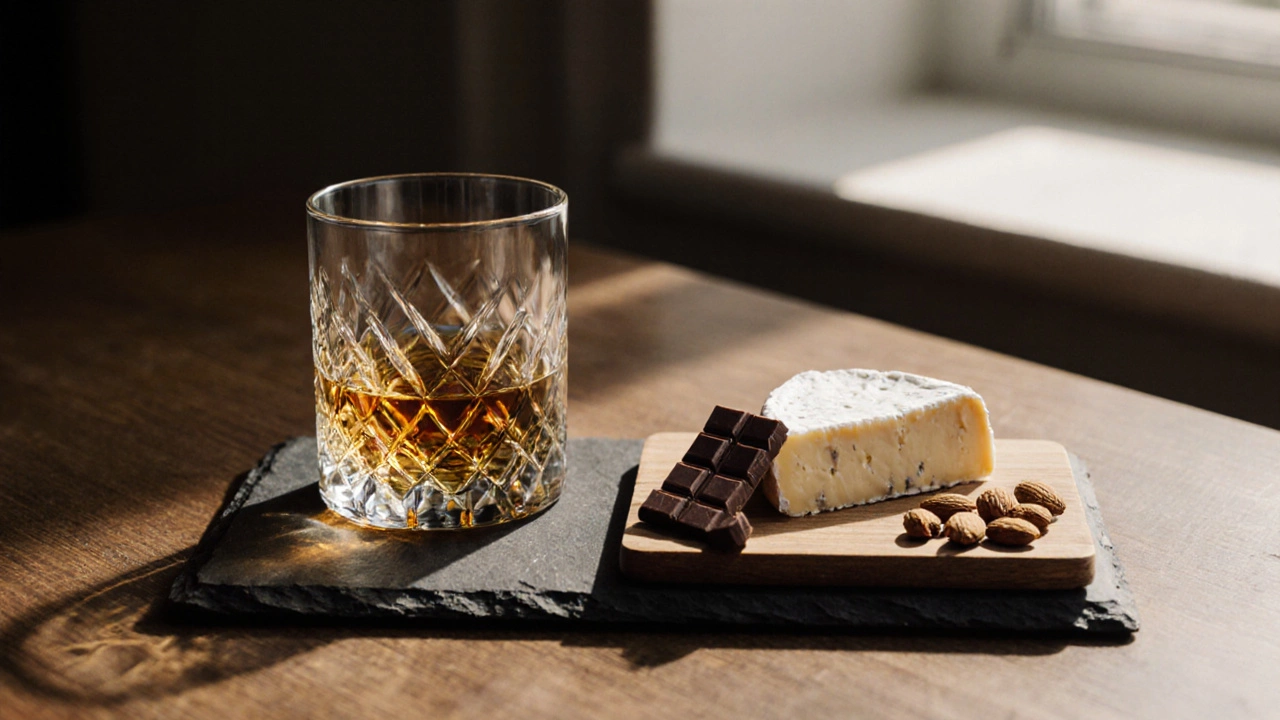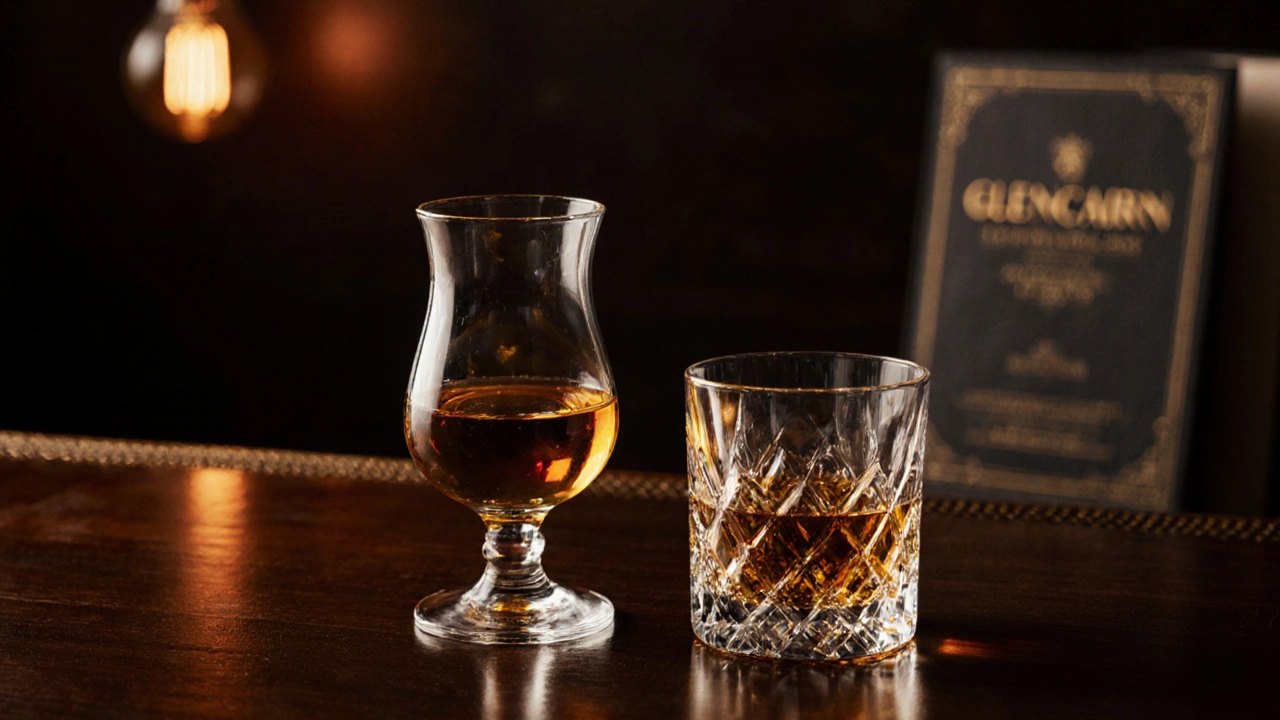Whiskey Dilution Calculator
Add water gradually, tasting after each addition
Expert Tips
Select your whiskey type and alcohol strength to see optimal dilution recommendations.
Key Takeaways
- Use a Glencairn or crystal tumbler for the best aroma capture.
- Serve whiskey at 15‑18°C; a splash of water can unlock hidden flavors.
- Hold the glass by the stem or base to keep your hand from warming the spirit.
- Pair with mild cheeses, dark chocolate, or roasted nuts for balance.
- Avoid adding too much ice or over‑diluting, which masks character.
Want to look like you belong at a high‑end bar without spending a fortune on classes? The answer lies in a few simple habits. From picking the right glass to mastering the pour, each step adds a touch of class to your whiskey experience. Below you’ll find a step‑by‑step guide that turns a regular dram into a polished moment.
Pick the Right Glassware
When you think of “classy,” a narrow, tapered glass probably comes to mind. That’s the Glencairn glass a short, tulip‑shaped vessel designed to concentrate aromas and showcase the whiskey’s color. The wide bowl narrows at the rim, guiding the scent straight to your nose while keeping the liquid in the palm of your hand.
If your budget allows, a crystal tumbler also known as a “rocks glass,” has thick walls that keep the drink cool and add a weighty feel. Tumbler lovers appreciate the solid base for stirring and the ability to serve “on the rocks” without making the glass look cheap.
Here’s a quick glance at how they differ:
| Feature | Glencairn | Crystal Tumbler |
|---|---|---|
| Shape | Tulip, narrow rim | Flat bottom, wide mouth |
| Best for | Neat tasting, aroma focus | On the rocks, mixed drinks |
| Typical volume | 30‑40ml | 45‑60ml |
| Heat transfer | Fast (hand‑warming) | Slow (thick crystal) |
Mind the Temperature and Dilution
Contrary to myth, whiskey isn’t always served ice‑cold. Most experts recommend a drinking temperature of 15‑18°C (59‑64°F). At this range the spirit’s volatile compounds are released without evaporating too quickly.
Start with the spirit at room temperature, then add a water splash usually 5‑10ml of still water if you feel the alcohol bite is too sharp. A tiny amount can open up caramel, vanilla, or fruit notes that were hiding.
Ice is a classic “on the rocks” approach, but it’s a double‑edged sword. Large, clear cubes melt slower, offering a gentle chill and a modest dilution over 20‑30 minutes. Avoid tiny cubes-their rapid melt will water down the whiskey in seconds, muting its character.

The Perfect Pour and Serving Etiquette
- Measure 30‑40ml for a neat pour. Use a jigger or a whisky measuring glass to keep it consistent.
- Hold the glass by the stem, base, or the lower part of the bowl. This prevents your hand heat from warming the spirit.
- Gently swirl the whisky for 2‑3 seconds. This releases aromatic compounds without splashing.
- Pause, inhale, and take a small sip. Let the liquid coat your tongue before swallowing.
- If you’re at a gathering, offer a water sidecar in a separate shot glass-this signals you’re confident about the drink and invites others to try it the same way.
Enhance Flavor with Water or Ice (When Appropriate)
Adding liquid isn’t a mistake; it’s a tool. The key is to add it incrementally. Start with one drop, swirl, evaluate, then decide if you need more. Most single malt Scotches show a noticeable shift after 5ml of water, while a bourbon may need up to 10ml to tame the sweetness.
When you do choose ice, a single large cube provides a “cold‑but‑controlled” experience. For a truly refined feel, try a single sphere of “whiskey ice,” a large clear sphere that can be reused for several drinks.
Pairing Whiskey with Food
Food pairing is a quiet way to show class. The rule of thumb: match the intensity of the spirit with the intensity of the bite.
- Cheese soft, mild varieties like Triple‑Crested Brie or aged Gouda cuts through the smoky notes of an Islay malt.
- Dark chocolate (70%+ cacao) highlights the rich, caramel side of a bourbon.
- Roasted almonds or walnuts bring out nutty undertones in a Speyside single malt.
- If you prefer something savory, a small slice of smoked salmon works well with a lightly peated whisky.
Serve the food on a separate platter, not inside the glass. This keeps the aroma profile pure while giving guests a chance to compare flavors side‑by‑side.

Common Mistakes to Avoid
- Holding the glass by the bowl-your body heat will alter the temperature.
- Using low‑quality ice that melts too fast.
- Pouring too much; a true tasting portion is 30‑40ml.
- Adding flavored mixers (like cola) unless you’re making a deliberate cocktail.
- Skipping the swirl-everything you lose is aroma, and aroma is half the experience.
Quick Reference Checklist
- Choose Glencairn for neat, crystal tumbler for rocks.
- Serve at 15‑18°C; consider a water splash.
- Measure 30‑40ml; hold by stem/base.
- Swirl gently, sip, evaluate.
- Pair with mild cheese, dark chocolate, or roasted nuts.
- Avoid overheating, over‑icing, and excessive dilution.
Frequently Asked Questions
What is the best glass for tasting whiskey?
The Glencairn glass is purpose‑built for tasting. Its shape concentrates aromas and lets you see the color clearly, making it the go‑to choice for both novices and pros.
Should I add water to every whiskey?
Not always, but a few drops can reveal hidden layers. Typically, a splash is helpful for cask‑strength or heavily peated whiskies. Start small; you can always add more.
Is there a rule for how much ice to use?
One large, clear cube-or a sphere-is ideal. It chills without diluting too quickly. Avoid crushed ice; it melts fast and masks flavor.
Can I pair whiskey with desserts?
Absolutely. Dark chocolate, caramel flan, or a simple shortbread cookie complement the sweet and smoky notes found in many whiskies.
What’s the difference between "neat" and "on the rocks"?
"Neat" means the spirit is served plain at room temperature, usually in a Glencairn. "On the rocks" adds ice, which cools and dilutes the drink over time, often served in a tumbler.


